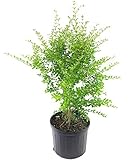All Categories





Live plant from Green Promise Farms Aronia arb. 'Brilliantissima' (Red Chokeberry) Shrub, 3-Size Container, White Flowers
Share Tweet
Get it between 2024-12-17 to 2024-12-24. Additional 3 business days for provincial shipping.
*Price and Stocks may change without prior notice
*Packaging of actual item may differ from photo shown
- Electrical items MAY be 110 volts.
- 7 Day Return Policy
- All products are genuine and original








Live plant from Green Promise Farms Aronia Features
-
LIVE PLANT: An underused native stunner, this narrow, upright growing shrub is easy to grow. Multi-stemmed with clusters of white to light pink flowers appear in spring. Flowers are followed by red fruits appearing in clusters along the branches and these ripen in late summer.
-
READY TO PLANT: Foliage emerges dark green and shiny and provides a great backdrop for profuse flattened heads of small white flowers in mid to late May that are filled with nectar for native bees. It can be planted immediately upon arrival, weather premitting. These plants are dormant with little to no leaves late fall to the winter months.
-
POPULAR USES: Brilliantissima is easy to grow, great for grouping and a must for providing bird shelter. From these flowers, berries occur, filling the plant with brilliant red fruit in the fall that many of our most prized bird species consider a delicacy.
-
PLANTING GUIDANCE: Red Chokeberry is Native to wet and dry climates. Thrives in full sun to part shade with average, medium moisture, well-drained soils. Best fruit production occurs more in full sun. For best results, plant in USDA Zone:4-8 - Mature size: 6-10ft H x 3-5ft W
-
SIZES: This Aronia is delivered right to your home in a #3 Size Container, 3 Gallon . We also offer a #2 Size Container, 2 Gallon.
About Live Plant From Green Promise Farms Aronia
A live outdoor plant from Green Promise Farms. ARONIA ARBUTIFOLIA`BRILLIANTISSIMA` Clusters of pinkish white flowers provide nectar for pollinators. Dense bunches of glossy red fruit ripen in summer and persist through the winter, providing food for birds. Foliage turns a brilliant red in autumn, great alternative to the non-native, burning bush (Euonymus alatus). Chokeberries aren't palatable to birds until they have been frosted multiple times, so the berries persist well into the season for you to enjoy. Grow TipsPlant in full sun to partial shade. This shrub is trouble free when planted in a rich, consistently moist soil. Be sure to provide plenty of space for growth. Prune in late winter or early spring for size reduction and rejuvenation.




















